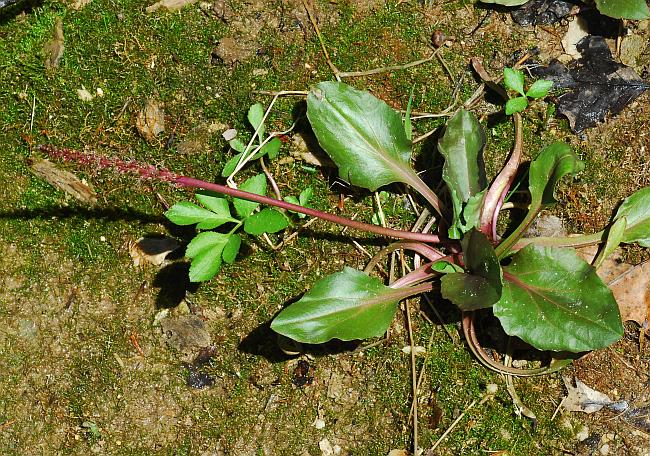Plantago cordata Lam.
Heartleaf Plantain

Native
CC = 10
CW = -5
MOC = 28
© SRTurner
Plantago cordata Lam.Heartleaf Plantain | |
 |
Native CC = 10 CW = -5 MOC = 28 |
© SRTurner |
|
Family - Plantaginaceae Habit - Perennial forb with several thick, fleshy, main roots. Stems - Absent or very short.
Leaves - Basal in a dense rosette, with long, winged and grooved petioles, strongly reddish tinged at the base, arched or spreading to loosely ascending. Blades 12-25 cm long, 7-20 cm wide (much shorter and only 1-3 mm wide in overwintering rosettes), ovate to broadly heart-shaped (those of overwintering rosettes rhombic-spatulate), angled to a rounded tip, rounded to shallowly cordate at the base, the margins entire or with irregular, blunt teeth, sometimes appearing undulate, the surfaces glabrous, appearing green to dark green, with 1 midvein and several pairs of strong secondary veins, some of these arising from the midvein well above the blade base.
Inflorescences - One to few per plant, elongate spikes 12-30 cm long, stout, 8-14 mm in diameter, loosely flowered (the axis visible between the flowers), the stalk 8-25 cm long, ascending at flowering, becoming trailing or prostrate at fruiting, glabrous, the axis becoming hollow as the flowers develop. Bracts 1.6-2.5 mm long, similar in length, shorter than the flowers (slightly shorter than the calyces), obovate, mostly with narrow brown to translucent, papery margins, not or only slightly keeled, often with a slender, slightly raised midnerve, truncate or broadly rounded at the tip, glabrous.
Flowers - Calyces deeply 4-lobed, 2.0-2.8 mm long, actinomorphic, ovate to elliptic-obovate, rounded or bluntly pointed at the tip, the slender, poorly developed keel glabrous, the narrow, brown to translucent margins thin and papery. Corollas not noticeably zygomorphic, the lobes 1.5-1.8 mm long, ovate-triangular with a truncate base, sharply pointed at the tip, the margins entire and often slightly inrolled, translucent white to tan, all of the lobes spreading at flowering, spreading or more commonly becoming somewhat reflexed at fruiting. Stamens 4, the anthers not horned.
Fruits - Fruits 5-10 mm long, ovoid to broadly ovoid, circumscissile at the midpoint or nearly so. Seeds 2 or less commonly 3 per fruit, 3-4 mm long, oblong-elliptic, the surface with a flattened or slightly concave area on 1 side near 1 end, otherwise smooth, strongly mucilaginous, tan to brown, more or less shiny, shed as a unit along with the associated placental matter.
Flowering - May - July. Habitat - Sloughs, rocky stream beds, spring branches, often emergent aquatics in shallow water. Origin - Native to U.S. Lookalikes - Broadly, P. rugelii. Other info. - This species is rare outside of Missouri, occurring in widely scattered locations in the eastern half of the continental U.S. In contrast, it is reasonably common in the eastern Ozark and Ozark border regions of Missouri. This is thought to be due to its preferred habitat of rocky stream beds, which in many other regions of the country have become silted in and unsuitable for the plant's occupation. This is easily the largest and most robust species of Plantago in Missouri and is easily recognized by its habitat, rosettes of large leaves with fleshy reddish petioles, and thick inflorescences. Photographs taken at Big Spring Park, MO., 6-11-04 (DETenaglia); also at Little Lost Creek Conservation Area, Warren County, MO, 4-25-2014 (SRTurner). |